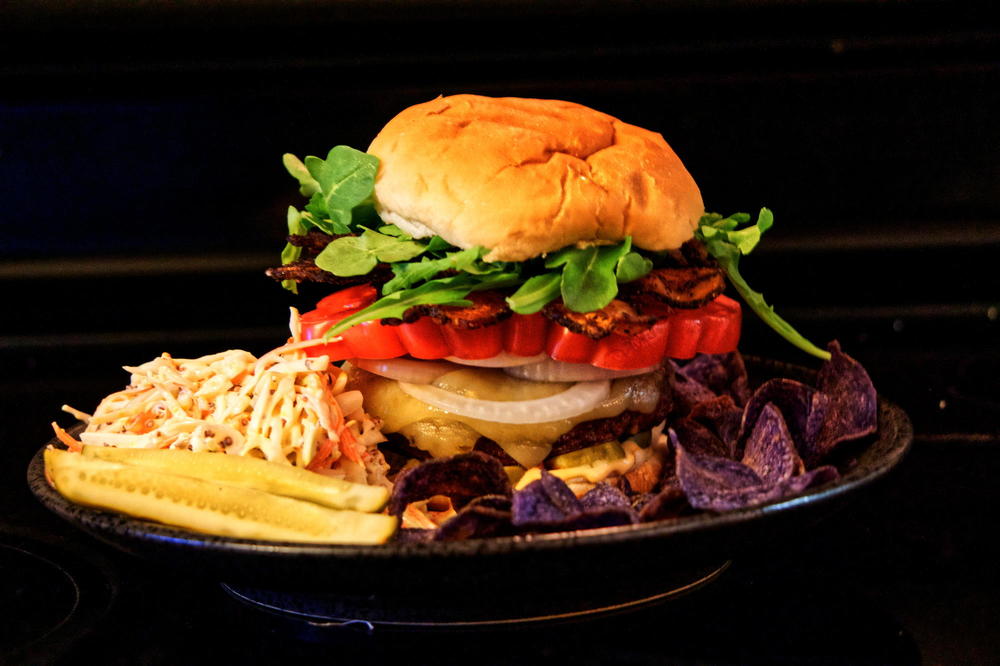-
Posts
1,807 -
Joined
-
Last visited
Content Type
Profiles
Forums
Store
Help Articles
Everything posted by btbyrd
-
I looked at them a couple years back when I was in the market for pans. Maybe something has changed recently, but I believe they’re just expensive carbon steel pans. I’m happy to see that they’re coming out with some new shapes, but I don’t know that there’s anything distinctive enough about them to justify the price. For single-piece construction carbon steel pans, Dartos represent a better value. They’re also thicker. The Ausion pans look very nice and I like the design, but that price...
-
Father's packaging kind of sucks. The last order I placed for a dozen hocks saw half a dozen unsealed. Some of the unsealed bags had been double sealed. I did my best to reseal them all with my chamber vac. Some hocks have now been triple sealed. It's mostly an issue with the harder, irregularly shaped products that bang around inside the box, but I've had issues with other products as well. It doesn't bother me with the ham so much, since it's super old and funky and oxidized anyway. But a bad seal can allow younger products like bacon to go rancid more quickly, and rancid bacon is no bueno. Especially when it's super smoky and otherwise beautiful country bacon. At any rate, they should revisit both their vacuum packing procedures and their box-packaging procedures. Seal it up better and keep it from banging around in the box. +1 to bluedolphin's recommendation of the end slices. They're very close to regular non-end bacon, and are only slightly irregular. Perfect for sandwiches in BLT season. And it's just fine to eat fried on its own as normal bacon unless you need perfect looking strips on the plate. If you're not particular about how your bacon looks, save the bucks and go for the ends.
-
Have you tried cooking it not in a bag? I'm not much of a fan of tender cuts of beef cooked SV. It can be convenient and easy, but I find it is seldom more delicious than cooking conventionally. SV steaks have a tendency to get a grainy. coarse texture that I don't really enjoy.
-
If you want a funk-punch umami bomb, go with the hock stock. If smoke is what you're after, go for the bacon, end slices, or bacon seasoning.
-
That's one of my favorites as well. It's like watching Sub Zero from Mortal Kombat throw down the ultimate fatality on an unsuspecting bird. It's one of the very few videos I've found that demonstrates the proper use of a honesuki / garasuki. I must have watched it a 20 times. There are lots of fun Related Videos on YouTube to explore.
-
I just started shooting and editing in RAW. It's amazing the details that you can bring out by adjusting the shadows and highlights. I've been editing in Affinity Photo on an iPad Pro, and very much enjoy the experience. My biggest hurdle at the moment is lighting. Daylight is in short supply and my kitchen is dark. I'd love to have a portable, preferably battery-powered lighting solution that doesn't cost a fortune but I don't know if such a thing exists. Soft boxes with hot lights are just too much. (At least, that's my impression.) I'm not going to leave a soft box up all the time, and I'll never use it if I have to set it up every time (unless setup is suuuuuuper quick and easy). A "point and shoot" rechargable LED (or something) light box would be ideal. Are these a thing? And if they are a thing, are they worth buying?
-
Leftover lasagna. This was one of the few times I've used my ultra-small Darto No. 15 pan. Just the right size to shallow fry four of these in EVOO without using too much oil.
-
All raw and semi-cooked chicken is cut on the wooden board with different knives than fully cooked chicken, which is cut on the plastic board with a different knife. I also suspect that his chicken is probably much nicer to handle than most of the birds available in North American grocery stores. Until a few years ago, all I knew were the slimy, mushy, soggy wet-chilled, pre-brined from Big Corn/Soy and the USDA. They're totally gross. Unpleasant to touch, look at, and even smell, much of the time. Now I'm buying air chilled heritage breed birds that have been minimally processed/handled (and are twice as old when they die, though that's another matter). Those are a joy to touch, behold, and even smell (well, that last one is kind of an exaggeration, but sometimes....). But I'll start another thread here in a bit on yakitori so we don't get too far afield in this thread.
-
You and me both, sister.
-
I'm fond of the genre that walks the line between travel video, guest experience, and documentary. Most of the videos are street food, or other forms of cooking where the food is prepared in front of the customer. High quality video with no real talking. Learn by watching. I can get lost in this type of video for hours. That's from "Travel Thirsty." They have a ton of similar content, but is one of the videos I learned the most from.
-
I use Diamond exclusively when cooking. I tend to use sea salts as finishing salts (Maldon or fleur de sel) rather than as something I'd cook with. Dishes where salt is an integral component (like salted caramel) might be an exception. I don't have anything against cooking with sea salt per se, but it all depends on which sea salt we're talking about. Some sea salts are better than others for different purposes.
-
Sure. This is within the context of cooking, not using on the table. (Though I will admit, I hadn't purchased table salt in over a decade until I was recently forced by circumstance into doing.) Table salt often has unnecessary additives such as iodine and anticaking agents like magnesium carbonate and sodium aluminosilicate. The particle size of table salt is the smallest of all the most common salts, which means that it weighs much more by volume. This small particle size is designed to facilitate flow from a shaker, but it's a liability when trying to dose salt by the pinch, dash, or spoonful. Because it's so highly concentrated by volume and because it's designed to flow quickly, over-seasoning is a constant worry. Also, I just don't like to touch the stuff. It's unpleasant on the fingers. Neither do I care for the giant flakes of Morton's kosher salt. That is a good choice for actually doing koshering or salting meat, but the large particle size makes it difficult to get an even coating without over-seasoning. The large grains can also pose a liability when baking. The giant grains also take forever to dissolve in a brine. Diamond Crystal kosher salt is the ideal particle size to actually touch with your hands. It's actually a mix of fine to medium sized particles, which makes it easy to grab and dose out with your fingers. It's easy to get even coverage when seasoning meat and vegetables without over-seasoning. Anecdotally, Diamond Crystal seems to be preferred by the vast majority of chefs for the reason that it's the perfect salt to actually season food with while you're cooking. And because the grains aren't super huge, you can bake with it as well, and it dissolves into brines relatively quickly. It's the best general purpose kitchen salt.
-
No. But standard table salt is pretty garbage. If someone wanted to wax on about the virtues of switching from table salt to something else in the context of cooking, the correct alternative is Diamond Crystal Kosher salt.
-
One of the first times I wrote in, Dave went on a rant about how my name sounded like some arena where they apparently used to have monster truck rallies. Or was it professional wrestling events? In any event, he ended up screaming my name in the manner of a monster truck rally TV commercial. "SUNDAY SUNDAY SUNDAY!" Another classic Dave digression.
-
My, that's some pricey snake oil.
-
The flax oil solution isn't to go the furniture-grade boiled linseed route, but to get the refrigerated stuff sold by hippies as a dietary supplement for goop-loving woo-worshipers. It will cost a fortune. It will not do anything special for your cast iron, and a lot of people find that it leaves a brittle layer of seasoning that fails by flaking off in big chunks. It also smells terrible. If you want a drying oil with a low smoke point that has a similar fatty acid profile to flax but isn't totally worthless, walnut oil is the best choice. It has a low smoke point. It polymerizes fast. Like flax, the omega 3 content makes your house smell like burning fish. It seasons no better than anything else I've tried, but it does smell much worse. I don't recommend using either. I do recommend using pretty much any oil that you already have in your kitchen that is designed to be put in your mouth. Not oils for treating your wooden cutting boards. Not drying oils for finishing woodworking projects or mysteriously applying to your gardening tools. Not any product you might have originally purchased to use on boots or a baseball glove. Don't be tempted to use lotion. Vaseline is right out. Likewise for Turtle Wax and anything else that is meant to buff cars to a mirrorlike shine. That includes Armor All. Hair products such as VO5 hot oil treatments are not suitable for seasoning cast iron. Neither is WD-40 or any other industrial lubricant. If you happen to be near a shipyard, do not attempt to season your pans with pitch or tar. Just use an oil you'd normally put in a salad dressing.
-
For God's sake, just use a culinary oil.
-
It has no special virtues and is otherwise useless in the kitchen. I'd cancel your order if you can. Also... if any of you are sitting on surplus bacon fat, cook with it. Using it to season metal is a waste.
-
There's more voodoo nonsense out there about seasoning cast iron (and carbon steel) than almost anything else in cookery. And that's saying something. Cast iron is basically indestructible. Back in the day, folks used to throw their pans in a bonfire once a year to burn off all the crud. Retrieve it from the coals, scrub and wash, and re-season from bare metal. You can bring back cast iron from the crustiest and rustiest of conditions. It will outlive us all. All the obsession with what lipid to use is misguided nonsense. I've used all kinds of oil, and now I use "whatever." The weak link in your seasoning chain is you, not your lack of superluxe Organic Peruvian flaxseed oil handpressed by virgins at the base of an active volcano on the night of the first full moon after the autumnal equinox. The most common error is using too much oil. The layer's gotta be so thin that it's basically not there. I wait for the pan to get hot and just before it starts smoking, I'll do a final scour with a clean paper towel to get any excess oil. Thick layers end up being gummy and disgusting. They're not even seasoning. They're just gross. Don't be that person with the sticky pans. Just don't. Apart from using too much oil, the other most common error is not doing enough layers. If you're trying to lay down a consistent base level of seasoning, you've gotta do it a bunch. Five times. Eight times. Ten or more times. Extra thin. Lotsa times. That's the recipe. As an example, this is a pizza steel that rusted out on me. I went at it with a lye soak and all kinds of sandpaper designed for metal. After a weekend of battle, this was about as close to "bare metal" as I could get it. Then a bunch of thin layers in the oven. Ten cycles. It was a total horror show before I started. Now it's bulletproof. Or as close to bulletproof as cast iron or carbon steel can be. Thin layers. Lotsa times.
-

Food Products That Really Suck and Should Never Be Made
btbyrd replied to a topic in Kitchen Consumer
As a time saver and courtesy, I place jarred garlic directly in the trash can. -
I just got the Auscrown Rambo. It's kinda pricey, but the build is very nice. Peizo ignition, braided stainless steel hose, chunky connectors, solid construction everywhere. It looks like it was put together by a team of people who were afraid of being sued by the end user. That's a good thing in my book. The burner itself looks almost exactly like the one in the original post that infernooo had shipped to him from Thailand. The high pressure regulator is a lightly modified Chen Fong CF103 and the braided stainless high pressure gas hose was made by ALO. So I suspect that the Rambo isn't much more than a rebranded Thai wok burner with a Chinese-supplied hose and regulator. But as a package, it hits all the right buttons. I was also looking at the offerings from Outdoorstirfry.com which seem very nice as well. But none of their product names were "Rambo," so... Here's the Auscrown product video.
-
The question was about vacuum levels for cook -> pasteurize -> chill -> store SV workflows. The displacement method only works for cook -> serve workflows. Vacuum packaging offers a number of additional functional benefits in the first context.
-
My main concerns with extra air in the bag are primarily about food quality rather than bacterial spoilage, although part of the reason you're vacuum sealing is to create an environment that's hostile to aerobic microorganisms. But if you're also cooking sous vide at times and temps that are long enough to pasteurize, I don't think it makes a huge difference (though I may be wrong about that). Once you've killed the microbes, you've killed the microbes. But another aspect of spoilage is lipid oxidation. More air = more oxygen = more oxidation = rancid food and "off flavors." And if you're freezing, extra air in the bag invites freezer burn. Concerns about "shelf life" are largely academic to me in this instance because I'm almost never vacuum packing delicate items with the intention to cook SV to pasteurization and then chill and store for extended periods. You aren't -- or you shouldn't -- cook fish for long enough to pasteurize anyway. And I sort of think sous vide chicken isn't all that awesome compared to other ways of cooking chicken. Everything else is robust enough to handle a strong vacuum. Do you have a particular application in mind? What needs a low vacuum level yet also is conducive to cook -> chill -> store SV practices?





